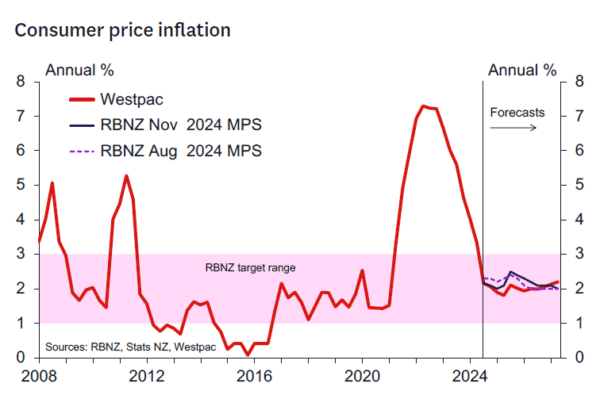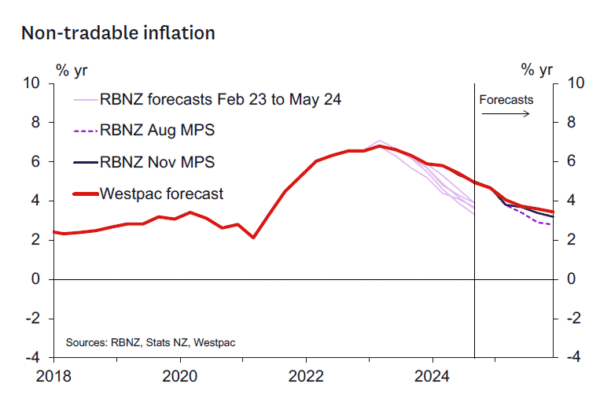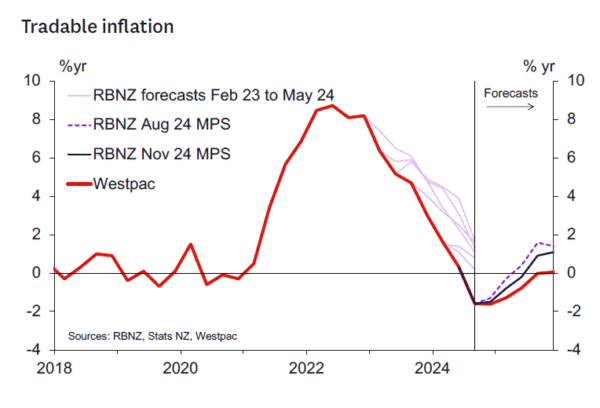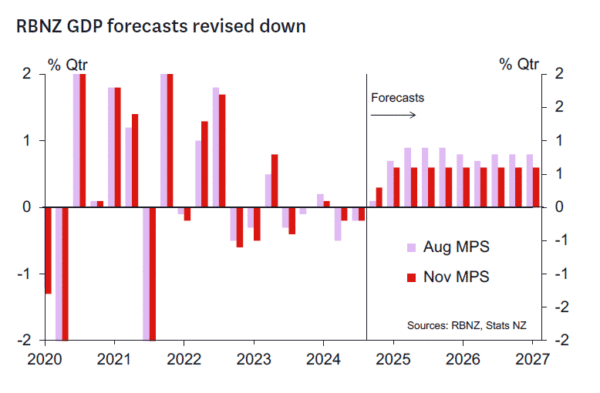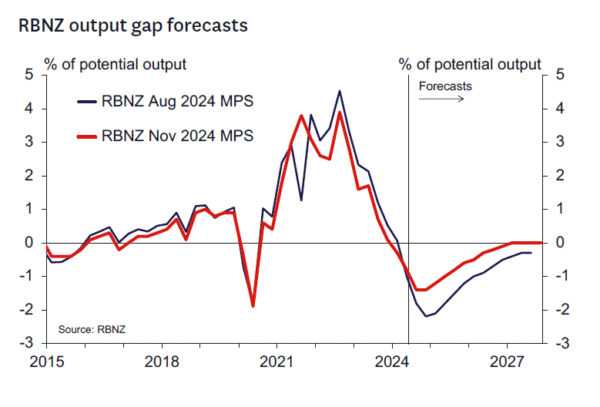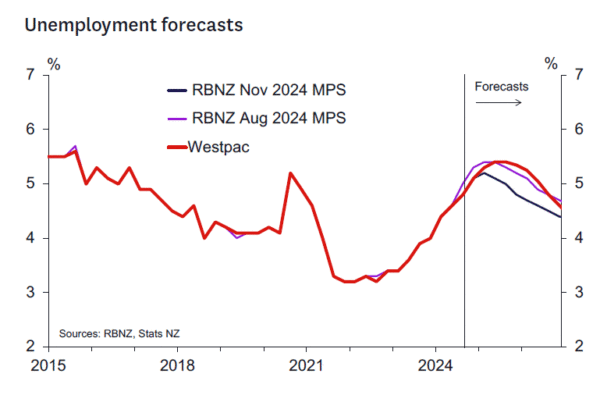- The RBNZ cut the OCR by 50bps to 4.25% at its final policy meeting for this year.
- The RBNZ’s OCR forecast profile was revised down as expected and now shows the OCR at 3.55% at the end of 2025. The Governor indicated the forward track was consistent with a 50bp cut at the February MPS but then a slower pace later in 2025.
- The Governor indicated the neutral OCR likely lies in the 2.5% – 3.5% range.
- Beyond this year, the RBNZ’s forecasts for economic growth have been revised down somewhat, reflecting a downward revision to assumed potential output (in particular, slower population growth due to smaller migrant inflows).
- Revisions to the RBNZ’s historical estimates of the output gap imply that there is less spare capacity than estimated previously, and thereafter a less negative gap over the forecast horizon than projected previously.
- The peak unemployment rate has been revised down to 5.2%, consistent with the starting point surprise seen in the Q3 data.
- Inflation is forecast to remain at or above 2% – non-tradables inflation has been revised up in the near term and is in line with Westpac’s forecasts.
- The RBNZ sees balanced risks for inflation. There remains some uncertainty on how quickly domestic inflation pressures will normalise, balanced by uncertainty on how quickly the economy will respond to interest rate cuts.
- We now think that it’s more likely than not that the RBNZ will cut the OCR by 50bp in February 2025, contingent on the economy and financial conditions evolving in line with our expectations.
- After that, uncertainty around the OCR outlook is higher, but we think the easing cycle will be over by mid-year, with the OCR still troughing at 3.5%.
Key take out: OCR cut 50bps, RBNZ signals a high chance of a 50bp cut in February.
As widely expected, the RBNZ cut the OCR by 50bps to 4.25%. The decision was reached by consensus and so no vote was taken.
The RBNZ’s projected track for the OCR was revised lower over 2025 but higher in 2026 from that seen in the August MPS.
- The projected average OCR in Q4 2025 was revised down 30bps to 3.55%. This is consistent with around 75bps of cuts in 2025 that the Governor noted would likely be largely frontloaded into the February 2025 meeting.
- The projected OCR for Q4 2026 was revised up 4bps to 3.17%, implying perhaps 1-2 25bps rate cuts in 2026.
- The RBNZ assumes the OCR reaches around 3.06% in Q4 2027 (the final quarter of the forecast).
According to the RBNZ, the most important driver of today’s decision was that inflation remains well-contained and the economy has significant excess capacity. Hence there remains scope to continue cutting the OCR towards the neutral zone.
The RBNZ seems interested in continuing to frontload cuts to get to the neutral zone. That looks like a decent chance of a 50bps cut in February and then just one more 25bp cut in 2025 – all going according to forecast. From then, the OCR profile flattens out noticeably and seems consistent with the idea that the easing cycle will be to all intents and purposes complete by mid-2025. We don’t see much here that is consistent with the more dovish views of global investors we noted in our recent Client Pulse survey.
The RBNZ continues to emphasize the data dependence of future OCR moves. Either a 25bps or 50bps easing could occur in February depending on the performance of the economy.
Risks to the RBNZ’s central projections.
The RBNZ singled out two key uncertainties regarding the near-term outlook – one concerning the persistence of some components of inflation where pricing behaviour is yet to normalise, and the other concerning the speed and timing of the recovery of growth in response to lower interest rates. The RBNZ also notes the possibility of greater inflation volatility over the medium term, reflecting geopolitical risks and climate-related energy and food risks. Other specific economic assumptions that are subject to uncertainty include the outlook for migrant inflows (and their impact) and the extent to which government spending evolves in a way that is consistent with the forecasts in Budget 2024 – the latter perhaps a warning shot to the Government as it begins to consider the fiscal strategy that will underpin Budget 2025.
Westpac’s OCR call.
Given the Governor indicated that he saw a high chance the OCR would be cut by another 50bp at the February MPS we would concur this is more likely than not. Our forecasts of the key data between now and the February MPS are not very different to the RBNZ’s – hence it’s hard to hang our hats on any specific piece of data that might move the RBNZ back to a 25bp move.
After that the outlook is murkier. We didn’t see anything today that suggests our view of the economy is different. Hence a 3.5% trough in the OCR mid-year still looks appropriate. We think that last 25bp cut will come at the May MPS. A skip in the April review seems consistent with the neutral zone getting very close and we do expect some very tangible signs of strength in the housing market by then. It should also be evident that the peak in the Unemployment rate will be near by April based on business surveys and strengthening consumer confidence.
RBNZ forecast detail: Domestic inflation pressures persist, but import prices pose downside risk to overall inflation.
The RBNZ’s updated forecasts show inflation sitting just above 2% for most of the projection period. Their longer-term inflation forecast is just slightly higher than they previously assumed, with domestic (non-tradables) inflation now expected to ease more gradually than the RBNZ assumed in August.
The upwards revision to the RBNZ’s forecasts for domestic inflation is consistent with their updated thinking on the economy’s productive capacity. As discussed below, the RBNZ now estimates that the economy’s rate of potential growth is lower than previously assumed, so there will be less spare capacity in the coming years than they had thought.
We agree with the RBNZ’s updated thinking on domestic inflation. Domestic inflation has consistently surprised to the upside of the RBNZ’s forecasts over the past two years. While inflation in interest rate-sensitive areas of the economy is cooling (like in the hospitality sector), we’re still seeing strong price increases in less interest rate-sensitive areas, like council rates and insurance premiums. That means total non-tradables inflation is only returning to average rates gradually. The RBNZ’s forecast for non-tradables inflation are now close to our own.
Despite the lingering firmness in domestic inflation, we still see downside risk to the RBNZ’s overall inflation forecasts as a result of weak imported prices (aka tradables inflation). Imported prices have been much weaker than the RBNZ assumed over the past year and have more than offset the persistence in domestic inflation. While the RBNZ expects inflation in these areas will lift relatively quickly over the year ahead, we think import prices will remain soggy for a while yet.
As a result, we think it’s likely that overall inflation will dip briefly below 2% in 2025. However, the undershoot of the target midpoint is likely to be temporary and modest and won’t alarm the RBNZ too much. Importantly, this is an area where the uncertain global backdrop will be crucial. Concerns about trade restrictions in the US have already pushed the NZD down in recent weeks, and that could limit or offset the falls in imported inflation that we’ve seen over the past year.
GDP growth forecasts revised lower.
Compared to August, the RBNZ is actually slightly more confident about a pickup in economic activity in the near term, lifting its forecast for December quarter GDP growth from +0.1% to +0.3%. Beyond that, though, the RBNZ has substantially revised down its estimates of both actual and potential output over the coming years. It now expects GDP growth of 2.3%y/y for December 2025, compared to 3.3%y/y in the August statement.
The RBNZ’s growth forecasts are very similar to our own for 2025 (we are slightly more optimistic about 2026).
This downgrade of the economy’s growth potential was driven by a few factors. First, the RBNZ has assumed that New Zealand’s poor productivity growth performance in recent years will continue. Second, the RBNZ now sees a stronger link between population growth and potential GDP growth – which amplifies the effects of a downward revision to its net migration forecasts for the next few years.
Notably, Stats NZ today foreshadowed that there will be an upward revision to GDP growth over the year to March 2023 and the year to March 2024 when the September quarter GDP figures are released next month. The updated projections presented in today’s MPS do not incorporate these revisions, and so are based on the data as last published with the release of the June 2024 quarter GDP figures back in September. These revisions are sufficiently historic that they don’t tell us much about the current degree of spare capacity in the economy, but they do show that New Zealand’s labour productivity in recent years hasn’t been quite as poor as was previously reported.
The net effect of the RBNZ’s revised GDP assumptions is that it now expects a substantially less negative output gap in the years ahead – i.e. less spare capacity in the economy, with the gap being closed sooner. This change is in turn reflected in the upward revision to the RBNZ’s forecasts of non-tradables inflation in the years ahead.
In a similar vein, the RBNZ has revised down its forecast of the peak unemployment rate for this cycle, from 5.4% to 5.2%. That partly reflects a lower-than-expected starting point, with the unemployment rate rising only to 4.8% in the September quarter, compared to the RBNZ’s forecast of 5.0%. The RBNZ is assuming that this shortfall will persist, with more people dropping out of the labour force altogether as hiring remains soft. We made a similar adjustment to our forecasts after the September quarter labour market surveys, though we still expect a higher peak next year of 5.4%.
Key domestic data to watch ahead of the RBNZ’s February 2025 Review.
The next RBNZ policy review will take place on 19 February 2025. Given the unusually long break until the next meeting, there will be a significant number of key domestic economic data releases ahead of that meeting. Indeed, the RBNZ will receive a new round of all of the top-tier quarterly indicators, and so there is plenty of scope for outcomes different to the 50bp rate cut signalled by the RBNZ. The most important releases are:
- The Q3 GDP report (19 December): The outcome of this report will be compared to the RBNZ’s estimate, with any deviation having implications for the RBNZ’s estimate of the output gap and perhaps also its view on near-term growth momentum. As noted earlier, revisions to historical GDP data will also have a bearing on the RBNZ’s assessment.
- The Q4 QSBO survey (14 January, TBC): The focus will be on indicators of spare capacity and cost/inflation pressures. It will also be interesting to see to what extent confidence, hiring and investment indicators are lifting from low levels as monetary conditions ease.
- The Q4 CPI (22 January) and January Selected Price Indexes (14 February): With headline inflation now close to the RBNZ’s 2% target midpoint, the focus will be on whether the composition of the CPI – including key non-tradables prices – is evolving in a manner consistent with it staying there over the coming year.
- Q4 labour market survey (5 February): Developments in both the unemployment rate and labour costs will be compared against the RBNZ’s updated estimates, while measures of labour input will provide some insight into how GDP might have fared during the quarter.
In addition to the above, key monthly activity indicators such as the BusinessNZ manufacturing and services indexes and the ANZ Business Outlook survey will also be of interest, as will developments in retail spending and housing indicators (albeit the latter tend to be difficult to read given that the housing market typically goes somewhat quiet over the holiday period). The Government’s Half-Year Economic and Fiscal Update and Budget Policy Statement (17 December) might also contain information bearing on expectations regarding the future stance of fiscal policy.
Aside from domestic indicators, the focus will be on any clarity that emerges regarding the implications of the Trump presidency for New Zealand’s export outlook and financial conditions (longer term interest rates and the exchange rate). The sustainability of this year’s rebound in dairy commodity prices will also move into focus as attention begins to turn to prospects for the 2025/26 season.





